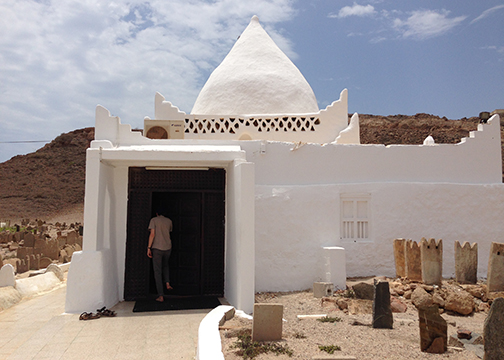PAYING RESPECTS IN DHOFAR
…we had discovered a real paradise in the wilderness, which will be a rich prize for the civilized nation which is enterprising enough to appropriate it.
–Theodore Bent, F.R.G.S., F.S.A. in Southern Arabia, 1900 (276)
…our war with colonialism, brother, is a long one.
–Dhofar Liberation Front radio broadcast, March 1967
“Where’s the grave of the Indian King?” I asked the men in Arabic, who were tossing volleyball-sized coconuts over a wall into the back of a truck.
“Cheruman Perumal?” the driver shouted as stuck his head out the window.
He did that characteristic Indian side-to-side head nod, signaling he knew which one I was talking about, and begun driving away as the coconut-throwers hopped in the bed of the truck with their loot. I took this as my signal to follow him, and ran back to the car where my wife, Emily, was waiting, sipping coconut water through a plastic straw.
We bumped along a dirt path in the cool shade of banana, mango, and tamarind trees for a few minutes, and the driver shook his wrist out the window and honked, not slowing or stopping. I recognized the building, which looked just a bit more worn from when I was here seven years ago. Three sticks of incense burned outside, and the door was latched shut. I knocked and unlocked the door, and there he was.
“Salaamu aleikum,” I said, and received no response.
Cheruman Perumal has been dead for fourteen hundred years. Nevertheless, it’s considered polite to say hello when entering his abode. Legend has it that the Hindu king was stargazing one night and saw the moon divide into two pieces, a miracle attributed to the Prophet Mohammed. He traveled to the city of Medina (in modern day Saudi Arabia) to meet the Prophet, converted to Islam, and set out on his return journey to India to spread the word. But he died in Salalah in the shade of the coconut trees, and is remembered with a modest structure over his stone sarcophagus, draped in a green satin shroud.
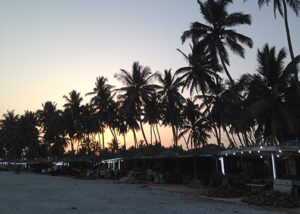
When I was last here in Dhofar, I was conducting research on pilgrims to an extensive network of graves of throughout the area. Salalah is the capital of Dhofar governorate, Oman’s southernmost and largest province, and is dotted with the tombs of notable sheikhs, saints, prophets, and pioneers to the region. Last time, I stayed in a small apartment above a Yemeni restaurant in downtown Salalah, and relied on the generosity of friends and passersby to get me to the graves, some as far as an hour away.
This time, after having difficulty with hotel arrangements — the place we had booked in advance had bed bugs — Emily and I took our car to scope out a brand new hotel just outside Salalah city limits. On the road leading out of town, we passed a tomb I hadn’t seen before, vacant and dusty on the horizon. As my mind drifted and I sped on the deserted road, I noticed military checkpoint ahead, a fairly common site in this remote part of Oman. A soldier in desert fatigues and a camouflage turban took our passports, looked in our trunk, and sent us on our way with a smile. I was surprised to see more police and military personnel at the hotel, patrolling the parking lot and the lobby with automatic weapons. Even so, the hotel looked squeaky clean, so we decided to check-in, assuming (correctly) there would be fewer insect residents in the beds.
A chatty lobby attendant in a gold vest showed us to our room, and informed us that His Excellency Yusuf bin Alawi, the Minister Responsible for Foreign Affairs[1] was visiting “with a delegation from Libya.” I had completely forgotten that the Libyan Constitutional Drafty Assembly (LCDA) was coming to Dhofar this week, and found it serendipitous that their visit coincided with our pre-planned trip. After mixed signals on whether or not they would come, the LCDA and top Omani diplomats had assembled in Salalah, in a conference room at the hotel, explaining the heightened security.
Yusuf bin Alawi is a singular figure in Omani, Middle East, and indeed global diplomacy. While His Majesty Sultan Qaboos is largely credited with opening the door to direct talks between Iran and the U.S., it was Yusuf bin Alawi who ferried back and forth among Tehran, Muscat, and Washington conveying messages and encouraging rapprochement. I saw bin Alawi the week before our trip on a panel with the most recent President of the Syrian National Council and the former Prime Minister of Yemen, two additional conflict-torn countries on which the peace-based Omani diplomatic machine is setting it sights. I was able to witness bin Alawi’s poise and incisive presence, and was surprised at how well versed he was on a wide range of topics (“We have seen, read, and analyzed the Atlantic interview with Obama”[2]).
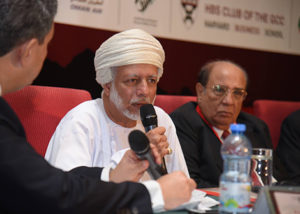
Just a few days later, he turned his focus to Libya. The setting for the LCDA meeting — on the mountain-rimmed shores of the Indian Ocean — was idyllic. Coconut palms and thatch-roofed huts dotted the beach at the hotel, and the welcoming smell of locally grown Dhofari frankincense filled the lobby. Aside from the Libyan and Omani delegates, middle-aged German and Italian vacationers ambled around the hotel, peering into chafing dishes at the buffet and doing wobbly poolside yoga in their swimsuits, oblivious to the diplomacy taking place in adjacent rooms.
Salalah is an attractive vacation destination and a primary source of tourist revenue for Oman. Dhofar is the only part of the Arabian Peninsula that receives the monsoon rains of the Indian Ocean, making it a tropical paradise for a few months of the year, known as the khareef.[3] Each summer, the rains turn the otherwise drab desert shrub landscape into a shockingly lush green oasis. Tropical fruits are grown year round in the fertile soil, and camels, cows, and goats graze on the abundant wild grasses in the high meadows for months after the rains stop. The monsoon also means that coastal Dhofar has its own microclimate of relatively cool weather year round — in a region known primarily for being arid. The whole phenomenon feels idiosyncratic and utterly un-Arabian.
From all over the Gulf, visitors flock to Salalah each summer by air and overland across the desert, to catch a glimpse of Dhofar’s misty highlands. During the khareef, traffic on the mountain roads leading to nowhere becomes a non-stop stream of bumper-to-bumper SUV’s, each with turbaned men and veiled women reaching their arms out the window to capture the glory and bounty of precipitation on their smartphones.
From the outside it looks like a paradoxical world, where everyone just loves miserable, rainy weather. Families set up leisurely outdoor picnics in the rain, and share photos of themselves sitting on the ground, drinking tiny cups of hot tea, soaked and smiling. Throughout the season, Omani TV carries wall-to-wall coverage of the khareef each night, with split-screen segments showing a series of cloudy, foggy hillsides and shorelines set to traditional music.
Adding to spectacle of the khareef are the cultural festivals, which showcase the regions distinct folk heritage, distinct from northern Oman and the rest of the Gulf. First and foremost, the various tribes of Dhofar speak Shehri, Mehri, Hobyot and Harsusi, the Modern South Arabian languages which all fall under the term lisaan jibbali, meaning “mountain tongues.”
Whereas Arabic and Hebrew are descended from Central Semitic languages like Aramaic and Phoenician, the jibbali languages are descended from South Semitic languages, long extinct and relegated to a forgotten corner of history. Even the dialect of Arabic spoken in Dhofar is different than the one spoken in northern Oman. Recently, in Muscat, while talking to a Dhofari I met in a barbershop, he said I “spoke like an Omani,” and asked if I could instead speak in Dhofari dialect or in jibbali. Alas, I could not, save for a few pleasantries.
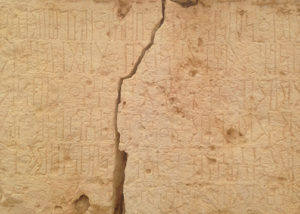
Aside from language, Dhofaris fall outside the network (and trappings) of tribal affiliations in the north, instead having their own system of caste-like tribal order based on origins, traditional professions, and association. Moreover, Dhofaris are almost uniformly Sunni, unlike the Ibadhis of Muscat and the Omani heartland. Even the traditional dress and handicraft culture is different from that of northern Oman.
Dhofar’s oldest and most renowned cultural export, however, is its frankincense. Ancient Dhofaris harnessed the fertile soil of the mountain valleys to grow the fickle boswellia sacra trees, whose sap is harvested and dried to form frankincense. A well-established overland trade route to the Mediterranean meant that Omani frankincense was burned in ancient Egyptian, Greek, and Roman temples, so precious that authors of the Bible eternalized it as a luxurious gift for an infant Jesus Christ. Gulf visitors eagerly buy the highest quality frankincense in bulk, which is sold at several dollars an ounce.
In the evening, visitors are delighted by Dhofar’s cultural riches. The state-sanctioned cultural competitions include exhibiting traditional Dhofari dancing (jumping with swords), athletic feats (jumping over a pommel-horse), and tribal poetry (sung in groups while jumping). Omani TV covers the festival live, with commentators excitedly interspersing updates on the wet and foggy weather.
Each year after the crowds leave, Salalah shutters half of its businesses and work starts to get ready for the next tourist season — what must surely be an exhausting cycle for the local government. During my most recent visit, just two months before the khareef started, the main artery that cuts through Salalah was completely dug up, with highway traffic routed through potholed back alleys. The goal is to build a number of overpasses to replace the roundabouts and traffic lights that get unbearably clogged during the khareef. In the meantime, simply getting from one side of the road to the other takes almost 15 minutes, and the residents are expressing frustration and disappointment at the delays, making me realize that complaints about sluggish public works seem universal.
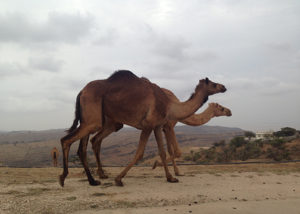
After weaving through the traffic cones and Jersey barriers of downtown Salalah, Emily and I passed throngs of camels grazing in the wide coastal plain on the road into the mountains. We were headed to another site of my previous research, said to be the tomb of Nabi Ayoub, or the Prophet Job from the Bible and Qur’an. The grave sits on the crest of the mountain chain overlooking Salalah; like the tomb of Cheruman Perumal nestled into a coconut grove, it’s an ideal final resting place. In the Qur’anic account of Job’s suffering, he is instructed by God to stomp his foot, which brings forth a spring of water that quenches his thirst and heals him. Sure enough, a chimney-like structure beside the tomb encases a footprint, preserved in rock. In the tomb’s sanctum, we said our salaams to Job and the other pilgrims, placed our hands on the green shroud covering his grave, and then headed further into the mountains.
A small fort with bright-green walls and corner turrets guards the narrow road that winds to Job’s tomb. It sits on the highest point of the surrounding mountains, and its concrete watchtowers have a panoramic view of the valleys and peaks below. It’s a firqat base, one of the many physical reminders of the decade-long Dhofar War waged between the mountain tribes and the government of the Sultanate.
While Muscat and the villages of the Dhofari coast have interacted for centuries, Salalah and its environs weren’t brought under the control of Omani sultans until the late 19th century. Importantly, the connection with Dhofar was by sea — from Muscat’s perspective, it was merely another port in Oman’s vast maritime realm, farther than Bandar Lengeh in Persia or Gwadar in Pakistan by sea. For Omani merchants and sultans, the open ocean between Muscat and Salalah was easier to tame than the unforgiving wasteland of vacant desert that separates them by land.
While successive Omani sultans dispatched representatives to keep Dhofar under the Sultanate’s thumb, His Majesty Sultan Qaboos’ father, Sultan Said bin Taimur, lived in Dhofar full-time and ruled over the province (and the Omani north) from Salalah. For much of the 20th century, Dhofar was Sultan Said’s permanent getaway, a place where it was easier to avoid the powerful merchants, warring tribes, and meddling British in Muscat and the Omani interior. The region was his own private tropical haven — but to the residents of Dhofar, it was his brutal fiefdom; he levied enormous taxes on its residents, interspersed himself into tribal conflicts of the area, and married from within the powerful mountain tribes.
In June 1965, as the first monsoon rains began, a few hundred Dhofari tribesmen gathered the mountains of central Dhofar. Among them were tribal sheikhs, members of the transnational Arab Nationalists Movement, the local Dhofar Benevolent Society, and Dhofari soldiers from various regional militaries. Dhofari migrant workers who had sought work in other parts of the Arab world returned and attended the meeting, and many brought with them new ideas about the direction of their homeland. The participants of the gathering gave themselves a new name — the Dhofar Liberation Front (DLF) — and resolved to emancipate their province from Sultan Said’s rule.[4]
At the time, the group was inspired by the ideology of Gamal Abdel Nasser, and was dedicated to countering perceived imperialist encroachments from Sultanic Oman and their enablers, the British. “Long Live Dhofar, Arab and Free” was their slogan, a nod to pan-Arab nationalism as well as its own separatist ambitions.[5] Of the 200 or so participants gathered at the meeting, which would later be called the First Congress, 18 people were elected to steer the revolutionary body’s activities. Among them was an outspoken 21-year-old named Yusuf bin Alawi, who would head the DLF office in Nasser’s Cairo.[6]
Guerillas from the Dhofar Liberation Front carried out a series of raids on government patrols and Western interests in the region, primarily focusing on the main road that connects Salalah with the Dhofari hinterland. In 1966, after successfully infiltrating the Sultan’s private guard, a group of rebels shot Sultan Said during an official colors ceremony — and while the Sultan survived, it marked the beginning of the end of his grip on power, and to an extent, reality.[7] A fence was built around the city of Salalah to keep rebels out and starve them of necessities from the port and the city’s souq, and the Sultan remained convinced that he could resolve what he considered to be a tribal matter by attrition, and without the help of the British.
Over time, the Dhofar Liberation Front radicalized further, suppressing its tribal and nationalist tendencies in favor of wholesale Marxist anti-colonial and anti-capitalist ideology, ultimately winning it support from the Soviet Union, China, Cuba, Palestine, and the nascent People’s Democratic Republic of Yemen. “The Front distributed as widely as it could Arabic translations of Revolutionary classics,” observed an Irish writer embedded with the guerillas. “Lenin’s State and Revolution and Imperialism, Marx’s and Engel’s The Communist Manifesto and writings of Mao, Stalin Ho Chi Minh and Che Guevara… formed part of the political education program taught to all cadres.”[8]
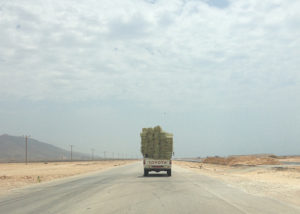
The embrace of revolutionary communist principles by the guerillas caused a fracture among the movement, which was already a loose association of Dhofari nationalists, Nasserites, communists, and tribesmen seeking autonomy over their grazing pastures. At the Second Congress, members voted to rename themselves the Popular Front for the Liberation of the Occupied Arabian Gulf (PFLOAG) to reflect newly-acquired regional ambitions and a broad anti-imperial stance.[9] This pushed some of the original tribal-nationalist elements of the movement away, including Yusuf bin Alawi, who chose to carry the banner separately under the DLF along with the rebel Musallim bin Nufl, seen by many as the father of the revolution.
PFLOAG gained some steam in its clashes across the region, inspiring less-successful parallel movement in Oman’s north called the National Democratic Front for the Liberation of Oman and the Arab Gulf (NDFLOAG). The deteriorating security situation caused by PFLOAG and NDFLOAG ultimately precipitated Sultan Said’s removal from power in July 1970.
The July 23 coup is often called “bloodless” in Western media, which isn’t the most accurate portrayal, as at least two individuals emerged with wounds. When Sheikh Burayq Al Ghafiri set the coup in motion by entering the royal quarters in the middle of the night, he was shot and wounded by a guard accompanying the Sultan. Then, after a scuffle in which Sultan Said (poetically) shot himself in the foot, the humiliated ruler agreed to abdicate in favor of his only son. Sayyid Qaboos, the Sandhurst-educated[10] child of a Dhofari mother from a prominent mountain tribe. He would become the twelfth Sultan of the House of Al Said.
The young Sultan quickly gained trust from a number of young Omani officials and British officers, and appealed to the rest of his countrymen at home and abroad to help bring the country “out of darkness.”[11] In one of his first addresses, when called on the Omanis living in Africa, India, and the Gulf to ‘return,’ he extended a wink and an olive branch to Dhofaris: “and to those who were not loyal to my father in the past, I say ‘let bygones be bygones, let bygones be bygones.’”[12]
Yusuf bin Alawi was one of the first to grab the branch, believing that Sultan Qaboos would overturn his father’s repressive policies and usher in an era of prosperity for Oman and Dhofar, and joined the Sultan’s government before the end of 1970.[13] In the following year, hundreds of guerillas defected to the side of Sultan Qaboos. With British help, the Sultan’s government organized these defectors into firqats,[14] or irregular militias, and used tribal and Islamic narratives to counter the socialist and communist ones they had previously been fighting under.
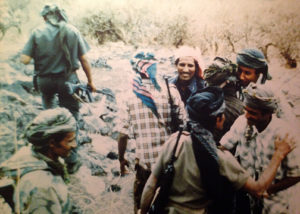
Firqat Salahuddin was the first to be formed, named for the anti-Crusader sultan and warrior of the Middle Ages. It was led by a sheikh from the Mashani, the tribe to which Qaboos’ mother belonged, and gradually amassed defectors from other tribes. When milita gained an early victory against rebel forces in eastern Dhofar, other militias comprised of former rebels began to form under the supervision of the British. Tribal conflicts eventually fractured Firqat Salahuddin, and all subsequent firqats were composed of single tribes who also named themselves for early Islamic figures, like Firqat Abu Bakr, Firqat Khalid bin Walid and Firqat Tariq bin Ziad.[15]
These militias were all given concessions for pledging their allegiance to the Sultan, including salaries, provisions, and new firearms, trading in clunky AK-47’s for Belgian light automatic rifles. They organized themselves in forts in secured mountainous tribal territory (like the one near Job’s tomb) and the coastal plain surrounding Salalah, providing crucial intelligence, logistical support in battles, and proving particularly useful for convincing their former comrades to give up the fight. Even thought British SAS officers led the firqats, they regarded them with suspicion, and thought they looked just like the “adoos” they were fighting. Despite this, their unparalleled knowledge of the local terrain proved integral in the wider scheme of the war.
After the Sultan’s forces defeated the rebellion, the firqat were permitted to keep their weapons, bases, and organizational structure. Today, they are a fifth pillar to the Royal Oman Police, the Royal Army, the Royal Airforce, and the Royal Navy of Oman. Firqat bases line the major roads around Dhofar, and the guerrillas-turned-loyalists still inhabit the bases as full-time jobs.
While seldom called upon, they remain an important part of the security landscape in Dhofar. In October 2015, as Cyclone Chapala was nearing the Yemeni and Omani coasts, the firqat sprung into action, announcing that they were “joining ranks” with the Royal Army of Oman to assist in search and rescue, in the canyons and mountains that they knew far better than the national forces. During the Arab Spring protests in 2011, one popular blogger said people felt the dispatching of Royal Army forces “like an invasion,” adding that it was obvious all of the soldiers were “from the north of Oman.”[16] The firqat were summoned to ease local tensions between Dhofaris airing their concerns, and members of the national army seeking to prevent serious unrest.
For the most part, however, they exist quietly on the sidelines, the bases serving as gathering centers for the tribal elders. Officially referred to as the Omani National Firqat Forces, public information on the militias is scant — even how many there are or what direct purpose they serve. They are ever present at cultural festivals and weddings across Dhofar, and are paraded around the north each year on National Day. “It seems their purpose is limited to chanting at festivals and celebrations,” an online commenter said dismissively, responding to a thread asking about them.[17]
Nonetheless, the firqat are a rare success story in the region’s long history of ill-advised ideological fanning and state backing of irregular militias. Consider the mujahideen in Afghanistan — tribal militias in mountainous Afghanistan who countered “godless” Soviet incursion with Islamist ideology — a strikingly similar situation with disastrous, far-reaching results. Perhaps rightfully, counterinsurgency in Dhofar and the development of the firqat continues to be used as a case study, but to limited success. Even so, it stands as a testament to the fact that militias and governments with competing ideologies can and have set aside their differences to chose stability over war, and to coexist and mutually prosper under a banner of national identity.
Back at the resort hotel in Salalah, the rebel-turned-diplomat Yusuf bin Alawi addressed his Libyan guests, whose country has been in a state of turmoil ever since Muammar Gaddhafi was removed from power.
“We lived your pains,” he said, alluding to the bitter conflict he himself was involved in, at the battles that took place on the ground beneath his feet, “and I hope you will emerge as a unified country. You have [the] capacity, you have strength, and you have the future in your hands.”[18]
The last grave Emily and I visited was my favorite of them all. The tomb of Muhammad bin Ali Al Alawi, a descendant of the Prophet Muhammad and migrant to Dhofar, and an important genealogical figure in a global network of Hadhrami Sufis scattered across the Indian Ocean. His mausoleum is surrounded by hundreds of smaller graves, and on our visit the entire cemetery was vacant. Even bin Ali’s tomb was shuttered and pitch black inside, so we blindly groped the walls inside before finding the light switch, saying our salaams, and exiting. Muhammad bin Ali was the sahib of Mirbat, and his resting place is just outside his town of Mirbat, the sight of the fiercest battle of the Dhofar War.
On our way out of town, we stopped at an ancient fort along the road, and found an elderly woman with hennaed hands and a nose ring selling frankincense and woven handicrafts. We chatted in Arabic about her wares, and she asked where I was from. When I told her I was American, she signaled that I was welcome, as a friend, in a roundabout way.
“The Americans are friends of Qaboos,” she said in a thick Dhofari acccent, “and we pledge allegiance to him.”
[1] Sultan Qaboos is the Minister of Foreign Affairs.
[2] Remarks by Yusuf bin Alawi, Muscat, April 2, 2016.
[3] Somewhat confusingly, khareef means autumn — but in the context of Dhofar, it means “monsoon.”
[4] Uzi Rabi, Emergence of States in a Tribal Society (2006): 194.
[5] Fred Halliday, Arabia Without Sultans (2001): 363.
[6] Calvin Allen, Oman Under Qaboos (2002): 27.
[7] Rabi, Emergence: 196.
[8] Halliday, Arabia: 369.
[9] Allen, Qaboos: 27.
[10] The alma mater of the kings of Jordan and Bahrain, the sultan of Brunei, emirs of Qatar and Abu Dhabi, ruler of Dubai, and Princes William and Harry, among others.
[11] “Khatib sahib al-jalala ila ash-shab, August 9, 1970,” accessed October 19, 2015, http://www.sultanqaboos.net/article-action-s-id-118.htm.
[12] Ibid.
[13] Nicholas Ridout & Jeremy Jones, A History of Modern Oman (2015): 152
[14] firqa, pl. firaq, but I will use the Anglicized firqat and firqats for purpose of clarity.
[15] Abdel Razzaq Takriti, Monsoon Revolution (2013): 270.
[16] http://dhofarigucci.blogspot.com/2011/05/tension-in-salalah.html
[17] http://archive.omaniaa.co/archive/index.php/t-604227.html
[18] https://www.mofa.gov.om/?p=7783&lang=en

